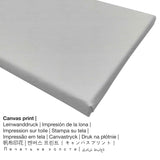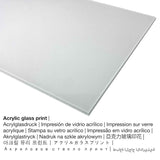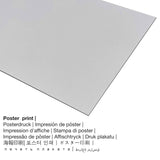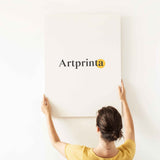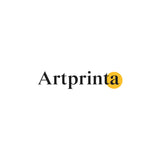Bernhard Fiedler, 1854 - Echiche nke Cairo - mbipụta nka mara mma
Ụtụ gụnyere. Mbupu gbakọrọ na ndenye ọpụpụ.
Additional specifications by Belvedere (© Copyright - Belvedere - www.belvedere.at)
The city of Cairo was 1853/54 led the last stop on a multi-month journey that Fiedler on behalf of the Prussian king Friedrich Wilhelm IV. Through Asia Minor, Syria, Palestine and Egypt. During this stay he painted a panorama-like view of the Egyptian metropolis, which he labeled "Cairo 1854". She is now in the Charlottenburg Palace in Berlin. In our painting is a large-scale repetition of this theme, which he made after his return to Trieste. Fiedler chose for this view a wide screen format on which he represented the city, as it presents itself from the Citadel: As almost unmistakable sea of houses, gardens, mosques and minarets. The view is directed to the west and extends over the green strip along the Nile to Giza, where just perceptible lift the pyramids, against the horizon out. The center of the image are the Sultan Hassan Mosque and the expanding front Rumêle Square. The mosque, on the part of those shows where the mausoleum of Sultan is surmounted with its monumental size, the entire city, leaving the buildings next to it almost miniatures of their own will; to characterize the people at Rumêle Square meet the painter at all, only multi-colored lines and dots. Fiedler was not there in his image but the description of life (although he has with the carpet dealer in the foreground genre-like features), but a documentation of the appearance of the city. This includes the Malkafs on the roofs in the foreground (the folded tops that catch coming from the Mediterranean cool north wind, and are designed to lead to the interior of the houses), and the reproduction of the partially ruinous state of individual buildings. The picture was painted in the early hours of the forenoon, to a time of day in which the air is still clear and fresh. The deep, rich blue of the sky will lose only towards the horizon towards its intensity, where it connects to the haze of the soil and the fluidized sand. The oblique sunlight of the morning also promotes the differentiation of light and shade and allows for rich gradation within the prevailing in the city browns. The same view of Cairo was stung by Fiedler in wood and displayed in the book published by Ebers 1879/80 zweibändigem work "Egypt in words and pictures." Literature: Material collection to a Austrian artist lexicon compiled by Rudolf Schmidt, stored in the library of the Austrian Gallery in Vienna. [Sabine Grabner, in: Mayr-Oehring, Erika (ed.), ORIENT. Austrian painting from 1848 to 1914, exh. Cat. Residenzgalerie Salzburg, Salzburg 1997]
Data ndabere na artpiece
| Aha nka nka: | "View of Cairo" |
| Nhazi: | sere |
| Okwu nche anwụ: | nkà nke oge a |
| Century: | 19th narị afọ |
| Emepụtara na: | 1854 |
| Afọ nka: | ihe karịrị 160 afọ |
| Usoro nka izizi: | mmanụ na kwaaji |
| Akụkụ ihe osise izizi: | 106 x 196 cm - etiti: 114 x 207 x 4 cm |
| Akara aka na nka nka: | signed and name on the bottom left. Bh Fiedler. in Trieste. |
| Egosiputara na: | Belvedere |
| Ebe ngosi nka: | Vienna, Austria |
| Webụsaịtị ihe ngosi nka: | Belvedere |
| Akwụkwọ ikike nka: | ngalaba ọha |
| Site n'aka: | © Belvedere, Vienna, nọmba ngwa ahịa: 2986 |
| kreditline ọrụ nka: | nyefee site na Kunsthistorisches Museum, Vienna na 1929 |
Banyere omenka
| aha: | Bernhard Fiedler |
| Aha ndị ọzọ: | fiedler bernh., Fiedler Bernhard, b. fiedler, fiedler, Fiedler Bernhard H., Bernhard Fiedler, fiedler bernhard von |
| Gender: | nwoke |
| Obodo onye nka: | German |
| Ọrụ: | onye na-ese ihe |
| Country: | Germany |
| nhazi ọkwa: | omenkà nke oge a |
| Ụdị nka: | Ihe ngosi |
| Nwụrụ anwụ: | 88 afọ |
| A mụrụ: | 1816 |
| Ebe omuma: | Berlin, Berlin State, Germany |
| Afọ ọnwụ: | 1904 |
| Nwuru na (ebe): | Trieste, mpaghara Trieste, Friuli-Venezia Giulia, Italy |
Ozi ihe ahaziri ahazi
| Nkewa edemede: | nka nka |
| Usoro mmeghari: | dijitalụ mmeputakwa |
| Usoro mmepụta: | mbipụta dijitalụ (Mbipụta UV ozugbo) |
| Mmalite ngwaahịa: | emepụtara na Germany |
| Ụdị ngwaahịa: | mmepụta ihe na-achọ |
| Ngwaahịa were: | ụlọ mmepụta ihe nka, mgbidi gallery |
| Nhazi: | usoro odida obodo |
| Oke akụkụ onyonyo: | ogologo ruo obosara 2: 1 |
| Nkọwa: | ogologo ahụ dị okpukpu abụọ karịa obosara |
| Nhọrọ dị: | mbipụta ọla (aluminium dibond), mbipụta akwụkwọ mmado (akwụkwọ kwaaji), mbipụta kanvas, mbipụta iko acrylic (nwere ezigbo mkpuchi iko) |
| Mbipụta kanvas (akwa akwa n'elu etiti ihe ndọtị) ụdị nha dị iche iche: | 40x20cm - 16x8 ", 60x30cm - 24x12", 80x40cm - 31x16", 100x50cm - 39x20", 120x60cm - 47x24", 160x80cm - 63x31", 180-x90cm |
| Mbipụta iko acrylic (nke nwere ezigbo mkpuchi iko): | 40x20cm - 16x8 ", 60x30cm - 24x12", 80x40cm - 31x16", 100x50cm - 39x20", 120x60cm - 47x24", 160x80cm - 63x31", 180-x90cm |
| Ụdị akwụkwọ mmado (akwụkwọ kwaaji) dị iche iche: | 60x30cm - 24x12", 80x40cm - 31x16", 100x50cm - 39x20", 120x60cm - 47x24" |
| Nhọrọ nha nha nke Dibond (ihe alumnium): | 40x20cm - 16x8", 60x30cm - 24x12", 80x40cm - 31x16", 100x50cm - 39x20", 120x60cm - 47x24" |
| Nhazi mmeputa nka nka: | biko mara na emebeghi ngwaahịa a |
Họrọ ihe ị ga-achọ inwe
Nchịkọta nhọrọ ngwaahịa na-enye gị ohere ịhọrọ nha na ihe ị họọrọ. Họrọ n'ime nhọrọ ngwaahịa ndị a ugbu a ka ị kwekọọ na mmasị gị na nha na akụrụngwa:
- Mbipụta iko acrylic (nke nwere ezigbo mkpuchi iko): An acrylic glass print, which is often referred to as a plexiglass print, transforms your favorite original into brilliant décor and is a viable alternative to dibond and canvas art prints. The great upside of a plexiglass art print is that contrasts and granular image details become identifiable because of the very fine tonal gradation.
- Mpempe akwụkwọ ederede (akwa akwa akwa): Our poster print is a UV printed canvas with a fine surface structure. Please bear in mind, that depending on the size of the canvas poster print we add a white margin between 2-6cm round about the painting to facilitate the framing with a custom frame.
- Aluminom ihe eji eme ihe: Aluminium Dibond prints are metal prints with a true depth effect - for a modern look and a non-reflective surface. The Aluminium Dibond Print is your perfect introduction to art replicas with aluminum. The white and bright parts of the artpiece shine with a silk gloss but without glow. This print on aluminium is one of the most popular entry-level products and is an extremely stylish way to showcase art prints, since it draws focus on the image.
- Kwaaji: The printed canvas applied on a wooden frame. A canvas has the special look of three-dimensionality. How can I hang a canvas print on the wall? Canvas prints are relatively low in weight, which implies that it is quite simple to hang your Canvas print without the support of additional wall-mounts. Therefore, a canvas print is suitable for any kind of wall.
Ozi ndabere ngwaahịa nka
View of Cairo was made by Bernhard Fiedler in 1854. The 160 year-old work of art was painted with the following size: 106 x 196 cm - frame: 114 x 207 x 4 cm and was painted on the medium mmanụ na kwaaji. "Signed and name on the bottom left. Bh Fiedler. in Trieste." is the painting's inscription. This artwork is included in the digital art collection of Belvedere, which is located in Vienna, Austria. Site n'ikike nke: © Belvedere, Vienna, nọmba ngwa ahịa: 2986 (public domain license). : transfer from the Kunsthistorisches Museum, Vienna in 1929. What is more, the alignment of the digital reproduction is in odida obodo format n'akụkụ akụkụ nke 2: 1, nke pụtara na ogologo ahụ dị okpukpu abụọ karịa obosara. Bernhard Fiedler was a painter, whose artistic style can be classified as Realism. The European artist lived for 88 years - born in 1816 in Berlin, Berlin state, Germany and deceased in the year 1904 in Trieste, Trieste province, Friuli-Venezia Giulia, Italy.
Ederede iwu dị mkpa: We try everything in order to depict our products as accurate as we can and to illustrate them visually. Although, the pigments of the printed materials, as well as the printing can diverge somehwat from the image on your screen. Depending on the screen settings and the nature of the surface, colors might not be printed as realisitcally as the digital version shown here. Since all are processed and printed manually, there might also be slight differences in the motif's exact position and the size.
© Nwebiisinka nke | www.artprinta.com (Artprinta)


